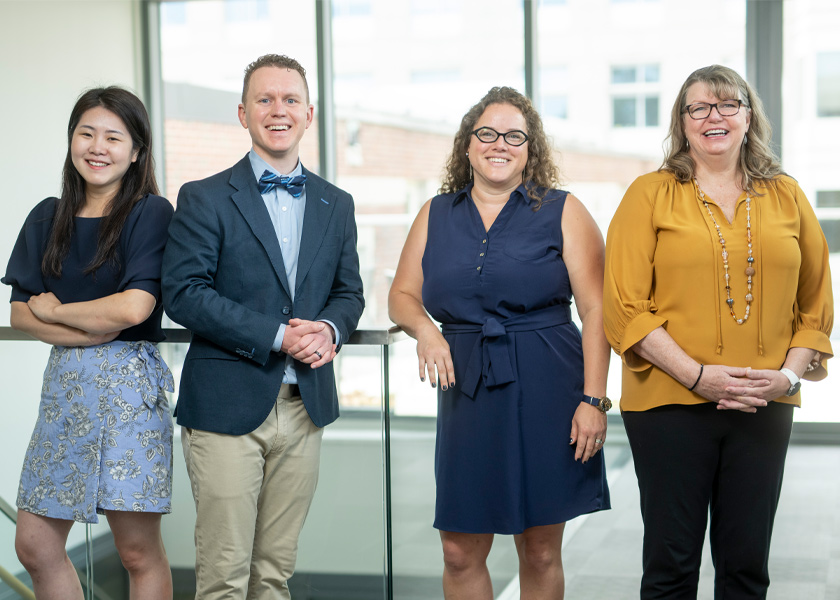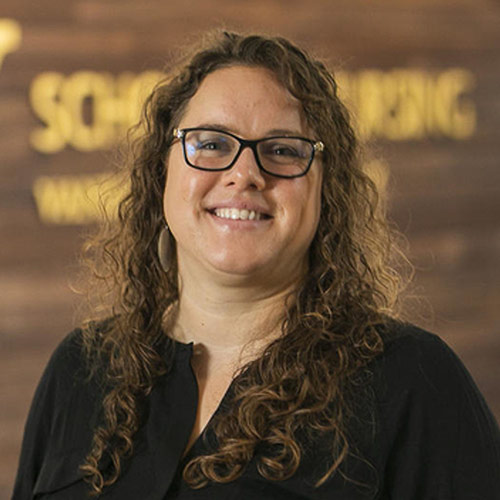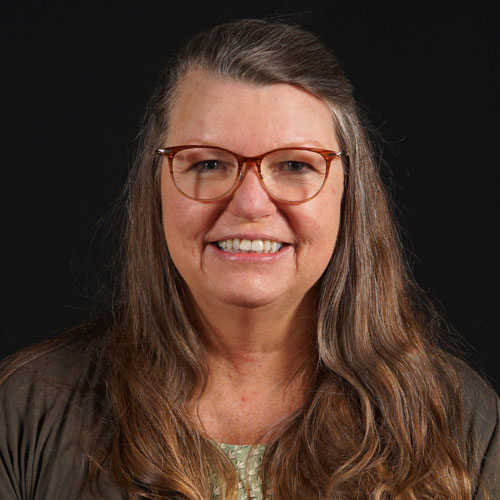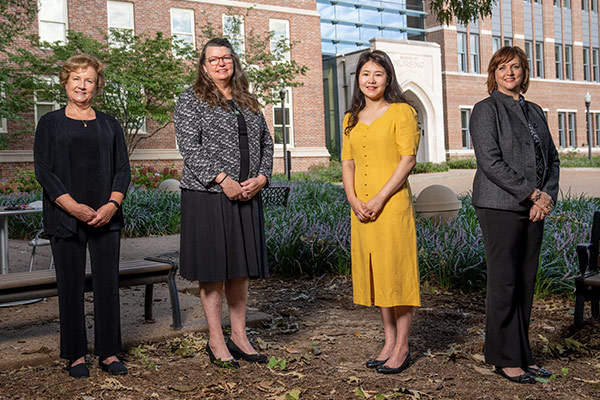With tech and big data come huge opportunities
Vanderbilt School of Nursing researchers are leveraging data science and health technology to improve health care at the individual and population-wide levels
By Melissa Shapiro
“The role of data science and technology continues to grow exponentially in health care delivery,” says School of Nursing Dean Pamela Jeffries, PhD, FAAN, ANEF, FSSH, the Valere Potter Distinguished Professor of Nursing. “New methods and discovery have the potential to impact large groups of patients, health care providers and health systems. You only need to look at the role data has played in forecasting and tracking the pandemic to see its value.”
With such a huge opportunity at our fingertips, Vanderbilt School of Nursing researchers, faculty and students have been successfully working to address open questions in their fields.
Leanne Boehm
Assistant Professor
Critically ill patients in the intensive care unit often experience pain, agitation, delirium, weakness and sleep deprivation that has been linked to post-intensive care syndrome: long term cognitive, physical and mental health problems. Leanne Boehm, PhD’16, MSN’09, FCCM, set out to address post-intensive care syndrome through data science methodologies.
During Boehm’s time interacting with patients as a bedside nurse, she developed an interest in implementing evidence-based care and pursued further education to do so. Through her clinical nurse specialist education and a doctoral fellowship in the VA Quality Scholars program, she was introduced to implementation science—the study of strategy and methods that encourage the implementation of evidence-based practice and research into actual health care use. Discovering how data science can help quality improvement and translational science, particularly for patients experiencing post-intensive care syndrome, has been the main focus of Boehm’s work ever since.
Boehm works with a framework called the ABCDEF bundle (Assess, prevent, and manage pain; Both awakening and breathing trials; Choice of sedation; Delirium: assess, prevent, and manage; Early mobility/exercise; Family engagement and empowerment). Although it is known to improve outcomes for critically ill patients, Boehm acknowledges that as a multidisciplinary team practice, it can be difficult to implement, and the ABCDEF bundle is underutilized in critical care. With an eye toward the organizational structure, process factors and patient factors that can improve ABCDEF bundle implementation, Boehm has developed and tested targeted data science-backed strategies at the organization, unit provider and patient level.
“Data science and my collaborative work with [fellow Vanderbilt nurse researcher] Alvin Jeffery have helped me to identify environmental factors that influence multidisciplinary protocol implementation in intensive care settings,” Boehm says. “Data science practices are also helping me identify phenotypes and trajectories of post-intensive care syndrome in order to better target candidates for the telehealth ICU Recovery Clinic.”
Boehm cites her multidisciplinary, international collaborations and relationship with the Critical Illness, Brain Dysfunction and Survivorship Center at Vanderbilt as central to her efforts to identify the recovery needs of ICU survivors and their family members, as well as helping her develop and implement ICU recovery programs working with physical/occupational therapists, physicians, psychologists, nurses, social workers and chaplains. She also credits the collaborative nature within the School of Nursing and its cohort of renowned data science experts, each with their own unique perspective and research interests, as contributing to meaningful, actionable and innovative clinical and research outcomes.
Alvin Jeffery
Assistant Professor
Alvin Jeffery’s expertise sits at the intersection of data and health care. His work with predictive analytics, machine learning and artificial intelligence is in the service of improving patient care. “There exist these mounds of data that could contain information that is key to improving some aspects of health care that are important to patients or to clinicians,” Jeffery, PhD’17, says.
Early in his academic career, Jeffery realized that he could share his expertise in analytics and coding to collaborate with other researchers focused on specific clinical care. His first start was predicting which hospital patients were going to deteriorate and getting that vital information to clinicians in ways that made sense to them. Ever since, he has been on a roll.
With Cathy Maxwell, PhD’12, FAAN, assistant professor of nursing, he has teamed up to create a predictive model that analyzes older adults’ injuries and their outcome trajectories; with fellow nurse scientist Leanne Boehm, PhD’16, MSN’09, he is considering how the availability of equipment in the ICU could influence how well health care providers adhere to evidence-based practice bundles. These all align with Jeffery’s focus on making the right information available at the right time to help clinicians make the best decisions for and with patients and their families.
In May 2022, Jeffery was named to the third cohort of the national Betty Irene Moore Fellowship for Nurse Leaders and Innovators. The three-year program will provide Jeffery the time and funding to conduct his latest project, Improving Electronic Health Record Usability with a Novel Customization Process.
“There’s a great deal of complex quantitative information bombarding clinicians these days, and I think a big reason why some advanced tools haven’t helped patients is because they’re not delivered in ways that are responsive to how health care workflows actually function,” Jeffery says. “With this fellowship, we’re developing a method that allows us to test different ways of displaying information and hopefully converging on meaningful solutions.”
Recently, Jeffery was awarded a $2.4 million, five-year grant from the National Institute on Drug Abuse. He’ll use the funding to develop technology and software that will use multiple types of data in the electronic health record to identify people likely to have substance use disorder, with the specific application of supporting genetic research. “The big difference this project can have is that we are changing how we define substance use disorder for research purposes and how we represent those people in the data that the computer analyzes,” Jeffery says. “The way that we’re thinking about our data and the outcome of our work is not to use data to definitively conclude that a patient has or does not have substance use disorder, but rather how they fall along a continuum.”
“There are really exciting opportunities, for those of us that know how to work with data, to collaborate with others in fields that may seem very different than ours,” Jeffery says. “One of the great things about being at Vanderbilt University is its affiliation with the Vanderbilt University Medical Center. The sharing of data, resources and expertise really allow those of us who are new to the field of research, and particularly those in informatics-focused research, to really take off with the existing infrastructure that’s available to us here.”
Chorong Park
Assistant Professor
With the ubiquity of online shopping, anyone with an email address has received a notification of a sale at a favorite retailer or a reminder email of some item that has been lingering in a virtual shopping cart waiting for purchase. This level of personalization is now being leveraged to improve health by Chorong Park, PhD.
Park has developed the Sit Less program, compiled of two research projects focused on monitoring sedentary behavior among chronically ill populations, such as those with type 2 diabetes and heart health concerns including coronary artery disease. By wearing a Fitbit, study participants passively share minute by minute information on their physical activity in the form of trackable data. School of Nursing Systems Analyst John Norfleet collaborated with Park to build the appropriate back-end data science approach to summarize raw data from the wearable tech into digests that become actionable information. This metabolized data is then fed through a third-party text message service that Park utilizes. It automatically sends personalized text messages to participants with words of encouragement to reach weekly activity level goals.
Focusing on sedentary behavior among those enduring chronic illness, Park has identified a population that is more challenging to reach with mainstream or existing interventions. Another important factor is that by keeping the effort to participate simple, people with lower health literacy including senior citizens, new immigrants and those for whom English is a second language, can take part. “People want to participate and to improve their health, but sometimes their health literacy is so low that we want to make it easy for them by using technology, instead of giving them the responsibility of answering surveys or taking phone calls,” Park says.
Park’s interest in this type of health technology and data science application grew during her postdoctoral studies at New York University. “I had a few mentors working in this area using devices to measure sleep and physical activity. I learned how to use the devices and technology to measure data rigorously,” Park says. “That was the first spark of my interest in this field.”
Illuminating new data-centric findings and other potential impacts of wearable technology are wide open and exciting. The sheer amount of data collected on individual behavior and then harmonized within the total participating group holds the potential to reveal insights that could have been a “needle in the haystack” or a connection between two elements that has never been previously identified. The impact of working with health technology and data science in health interventions like Park’s satisfies short-term, long-term, individual and population-wide considerations.
Lori Schirle
Assistant Professor
Lori Schirle, PhD, focuses on understanding pain and opioid use. Her work spans the many facets of how people handle and receive treatment for their pain, from measuring opioid use through novel Bluetooth technology that tracks how and when medication containers are opened to capturing pain sensitivity measures, analysis of genetic and gene expression data, and quantifying of centralized pain in health records.
Centralized pain in chronic conditions like fibromyalgia, irritable bowel disease or rheumatic arthritis is a unique phenomenon because the brain and central nervous system act to augment pain sensations that result in pain outside of what would be expected from a stimulus, according to Schirle. Worse for those suffering, there is no diagnostic code for pain, meaning there is no classification nor legitimization of the very real sensations patients suffer through.
To address this gaping need, Schirle is working on a pilot project, Detecting Centralized Pain in Electronic Health Record Data, funded by the Vanderbilt Institute for Clinical and Translational Research. “We devised a method of detecting and grading centralized pain using diagnostic codes for these chronic painful conditions found in the health records,” Schirle says. “Centralization of pain is believed to impact the transition from acute to chronic pain, and also the effectiveness of various treatments for pain. Using what we termed the Centralized Pain Score, we’re working on a reliable method to detect centralized pain in electronic health record data, which would help further both pain and opioid research.”
Funding from Vanderbilt University’s Seeding Success program is being used by Schirle and her team to investigate potential reasons for the great variation seen in patients’ pain and opioid use after similar surgeries. “We are investigating how an individual’s pain sensitivity and genetic makeup influence postoperative pain and opioid use after total knee replacement,” Schirle says. “We hope to be able to understand how pain sensitivity changes over the course of the surgical period, and if genetic or pain sensitivity are associated with opioid use after surgery.”
Schirle’s work is essential in this region, as Tennessee, in particular, has been hard hit by the adverse effects of opioids. In 2020, close to 80 percent of overdose deaths in the state were caused by synthetic and prescription opioids, according to the Department of Health. With credit to the School of Nursing’s myriad expert collaborators and data science students, as well as the “team science” atmosphere fostered across the university and medical center, Schirle continues to make significant strides in improving the lives of many.
Schirle views data science techniques as integral to her work and a natural result of where her research questions have led her. The techniques she uses to conduct her work have made it difficult to imagine moving forward with health research without incorporating some degree of data science in all current and future projects. “The human body is so complex, with biological and psychological factors interacting with environmental and social ones, that it is difficult for humans to comprehend,” Schirle says. “It takes data science techniques such as machine learning and AI to comprehensively analyze this complexity. Expanding these concepts out to incorporate health systems and populations is an even grander task.”












